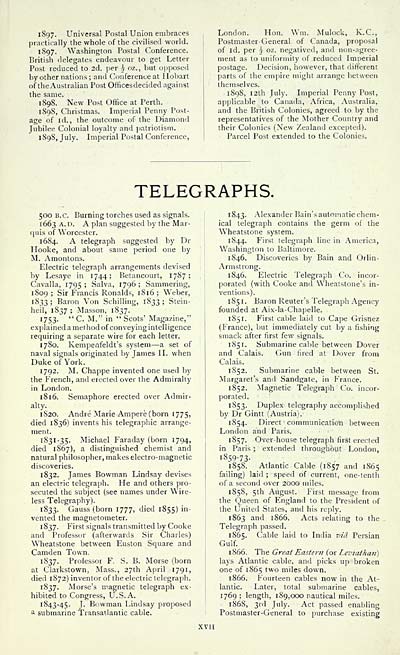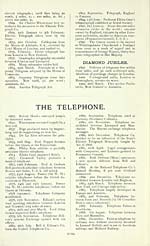Scotland > 1862, 1868, 1872, 1882-1885, 1893-1896, 1901-1904 - County directory of Scotland > 1901-1904
(27)
Download files
Complete book:
Individual page:
Thumbnail gallery: Grid view | List view

iSgj. Universal Postal Union embraces
practically the whole of the civilised world.
1897. Washington Postal Conference.
British delegates endeavour to get Letter
Post reduced to 2d. per i oz., but opposed
by other nations ; and Conference at Hobart
of the Australian Post Offices decided against
the same.
1898. New Post Office at Perth.
1898, Christmas. Imperial Penny Post-
age of id., the outcome of the Diamond
Jubilee Colonial loyalty and j)atriolism.
1898, July. Imperial Postal Conference,
London. Hon. Wni. Mulock, K.C.,
Postmaster-General of Canada, proposal
of id. per i oz. negatived, and non-agree-
ment as to uniformity of reduced Imperial
postage. Decision, however, that different
parts of the empire might arrange between
themselves.
1898, I2th July. Imperial Penny Post,
applicable to Canada, Africa, Australia,
and the British Colonies, agreed to by the
representatives of the Mother Country and
their Colonies (New Zealand excepted).
Parcel Post extended to the Colonies.
TELEGRAPHS.
500 B.C. Burning torches used as signals.
1663 A.D. A plan suggested by the Mar-
quis of Worcester.
1684. A telegraph suggested by Dr
Hooke, and about same period one by
M. Amontons.
Electric telegraph arrangements devised
by Lesaye in 1744; Betancourt, 1787;
Cavalla, 1795; Salva, 1796; Sammering,
1809 ; Sir Francis Ronalds, 1816 ; Weber,
1833 ; Baron Von Schilling, 1833 ; Stein-
heil, 1837 ; Masson, 1837.
1753- " C. M." in "Scots' Magazine,"
explained a method of conveying intelligence
requiring a separate wire for each letter.
1780. Kempenfeldt's system — a set of
naval signals originated by James II. when
Duke of York.
1792. M. Chappe invented one used by
the French, and erected over the Admiralty
in London.
1816. Semaphore erected over Admir-
alty.
1820. Andre Marie Ampere (born 1775,
died 1836) invents his telegraphic arrange-
ment.
1831-35. Michael Faraday (born 1794,
died 1867), a distinguished chemist and
natural philosopher, makes electro-magnetic
discoveries.
1832. James Bowman Lindsay devises
an electric telegraph. He and others pro-
secuted the subject (see names under Wire-
less Telegraphy).
1833. Gauss (born 1777, died 1855) in-
vented the magnetometer.
1837. First signals transmitted by Cooke
and Professor (afterwards Sir Charles)
Wheatstone between Euston Square and
Camden Town.
1837. Professor F. S. B. Morse (born
at Clarkstown, Mass., 27th April 1791,
died 1872) inventor of the electric telegraph.
1837. Morse's magnetic telegraph ex-
hibited to Congress, U.S.A.
1843-45. J. Bowman Lindsay proposed
a submarine Transatlantic cable.
1843. Alexander Bain's automatic chem-
ical telegraph contains the germ of the
Wheatstone system.
1844. First telegraph line in America,
Washington to Baltimore.
1846. Discoveries by Bain and Orlin-
Armstrong.
1846. Electric Telegraph Co. incor-
porated (with Cooke and Wheatstone's in-
ventions).
1 85 1. Baron Reuter's Telegraph Agency
founded at Aix-la-Chapelle.
185 1. First cable laid to Cape Grisnez
(France), but immediately cut by a fishing
smack after first few signals.
185 1. Submarine cable between Dover
and Calais. Gun fired at Dover from
Calais.
1852. Submarine cable between St.
Margaret's and Sandgate, in France.
1852. Magnetic Telegraph Co. incor-
porated.
1853. Duplex telegraphy accomplished
by Dr Gintt (Austria).
1854. Direct communication between
London and Paris.
1857. Over-house telegraph first erected
in Paris ; extended throughout London,
1859-73-
1858. Atlantic Cable (1857 and 1865
failing) laid ; speed of current, one-tenth
of a second over 200G miles.
1858, 5th August. First message from
the Queen of England to the President of
the United States, and his reply.
1863 and 1866. Acts relating to the
Telegraph passed.
1865. Cable laid to India 7Jta Persian
Gulf.
1866. The Great Eastern Cor Leviathan)
lays Atlantic cable, and picks up broken
one of 1865 two miles down.
1866. Fourteen cables now in the At-
lantic. Later, total submarine cables,
1769 ; length, 189,000 nautical miles.
• 1868, 3rd July. Act passed enabling
Postmaster-General to purchase existing
XVII
practically the whole of the civilised world.
1897. Washington Postal Conference.
British delegates endeavour to get Letter
Post reduced to 2d. per i oz., but opposed
by other nations ; and Conference at Hobart
of the Australian Post Offices decided against
the same.
1898. New Post Office at Perth.
1898, Christmas. Imperial Penny Post-
age of id., the outcome of the Diamond
Jubilee Colonial loyalty and j)atriolism.
1898, July. Imperial Postal Conference,
London. Hon. Wni. Mulock, K.C.,
Postmaster-General of Canada, proposal
of id. per i oz. negatived, and non-agree-
ment as to uniformity of reduced Imperial
postage. Decision, however, that different
parts of the empire might arrange between
themselves.
1898, I2th July. Imperial Penny Post,
applicable to Canada, Africa, Australia,
and the British Colonies, agreed to by the
representatives of the Mother Country and
their Colonies (New Zealand excepted).
Parcel Post extended to the Colonies.
TELEGRAPHS.
500 B.C. Burning torches used as signals.
1663 A.D. A plan suggested by the Mar-
quis of Worcester.
1684. A telegraph suggested by Dr
Hooke, and about same period one by
M. Amontons.
Electric telegraph arrangements devised
by Lesaye in 1744; Betancourt, 1787;
Cavalla, 1795; Salva, 1796; Sammering,
1809 ; Sir Francis Ronalds, 1816 ; Weber,
1833 ; Baron Von Schilling, 1833 ; Stein-
heil, 1837 ; Masson, 1837.
1753- " C. M." in "Scots' Magazine,"
explained a method of conveying intelligence
requiring a separate wire for each letter.
1780. Kempenfeldt's system — a set of
naval signals originated by James II. when
Duke of York.
1792. M. Chappe invented one used by
the French, and erected over the Admiralty
in London.
1816. Semaphore erected over Admir-
alty.
1820. Andre Marie Ampere (born 1775,
died 1836) invents his telegraphic arrange-
ment.
1831-35. Michael Faraday (born 1794,
died 1867), a distinguished chemist and
natural philosopher, makes electro-magnetic
discoveries.
1832. James Bowman Lindsay devises
an electric telegraph. He and others pro-
secuted the subject (see names under Wire-
less Telegraphy).
1833. Gauss (born 1777, died 1855) in-
vented the magnetometer.
1837. First signals transmitted by Cooke
and Professor (afterwards Sir Charles)
Wheatstone between Euston Square and
Camden Town.
1837. Professor F. S. B. Morse (born
at Clarkstown, Mass., 27th April 1791,
died 1872) inventor of the electric telegraph.
1837. Morse's magnetic telegraph ex-
hibited to Congress, U.S.A.
1843-45. J. Bowman Lindsay proposed
a submarine Transatlantic cable.
1843. Alexander Bain's automatic chem-
ical telegraph contains the germ of the
Wheatstone system.
1844. First telegraph line in America,
Washington to Baltimore.
1846. Discoveries by Bain and Orlin-
Armstrong.
1846. Electric Telegraph Co. incor-
porated (with Cooke and Wheatstone's in-
ventions).
1 85 1. Baron Reuter's Telegraph Agency
founded at Aix-la-Chapelle.
185 1. First cable laid to Cape Grisnez
(France), but immediately cut by a fishing
smack after first few signals.
185 1. Submarine cable between Dover
and Calais. Gun fired at Dover from
Calais.
1852. Submarine cable between St.
Margaret's and Sandgate, in France.
1852. Magnetic Telegraph Co. incor-
porated.
1853. Duplex telegraphy accomplished
by Dr Gintt (Austria).
1854. Direct communication between
London and Paris.
1857. Over-house telegraph first erected
in Paris ; extended throughout London,
1859-73-
1858. Atlantic Cable (1857 and 1865
failing) laid ; speed of current, one-tenth
of a second over 200G miles.
1858, 5th August. First message from
the Queen of England to the President of
the United States, and his reply.
1863 and 1866. Acts relating to the
Telegraph passed.
1865. Cable laid to India 7Jta Persian
Gulf.
1866. The Great Eastern Cor Leviathan)
lays Atlantic cable, and picks up broken
one of 1865 two miles down.
1866. Fourteen cables now in the At-
lantic. Later, total submarine cables,
1769 ; length, 189,000 nautical miles.
• 1868, 3rd July. Act passed enabling
Postmaster-General to purchase existing
XVII
Set display mode to: Large image | Transcription
Images and transcriptions on this page, including medium image downloads, may be used under the Creative Commons Attribution 4.0 International Licence unless otherwise stated. ![]()
| Scottish Post Office Directories > Scotland > County directory of Scotland > 1901-1904 > (27) |
|---|
| Permanent URL | https://digital.nls.uk/85502899 |
|---|
| Description | County directory of Scotland(For 1901-1904) |
|---|---|
| Attribution and copyright: |
|
| Description | Irregular. Published 1862-[1912?] |
|---|---|
| Shelfmark | Map.Ref.C18 |
| Additional NLS resources: | |
| Description | Directories of the whole, or large parts of, Scotland. |
|---|
| Description | Around 700 Scottish directories published annually by the Post Office or private publishers between 1773 and 1911. Most of Scotland covered, with a focus on Edinburgh, Glasgow, Dundee and Aberdeen. Most volumes include a general directory (A-Z by surname), street directory (A-Z by street) and trade directory (A-Z by trade). |
|---|


